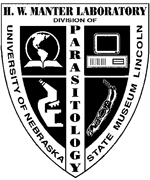Parasitology, Harold W. Manter Laboratory of

Harold W. Manter Laboratory of Parasitology: Library Materials
Document Type
Article
Date of this Version
2015
Citation
Veterinary Parasitology (2015) 213: 76-84
doi: 10.1016/j.vetpar.2015.07.035
Abstract
Echinococcus granulosus, formerly regarded as a single species with a high genotypic and phenotypic diversity, is now recognized as an assemblage of cryptic species, which differ considerably in morphology, development, host specificity (including infectivity/pathogenicity for humans) and other aspects. This diversity is reflected in the mitochondrial and nuclear genomes and has led to the construction of phylogenetic trees and hypotheses on the origin and geographic dispersal of various taxa. Based on phenotypic characters and gene sequences, E. granulosus (sensu lato) has by now been subdivided into E. granulosus sensu stricto (including the formerly identified genotypic variants G1-3), Echinococcus felidis (the former ‘lion strain’), Echinococcus equinus (the ‘horse strain’, genotype G4), Echinococcus ortleppi (the ‘cattle strain’, genotype G5), and Echinococcus canadensis. The latter species, as recognized here, shows the highest diversity and is composed of the ‘camel strain,’ genotype G6, the ‘pig strain’, genotype G7, and two ‘cervid strains,’ genotypes G8 and G10. There is debate whether the closely related G6 and G7 should be placed in a separate species, but more morphological and biological data are needed to support or reject this view. In this classification, the application of rules for zoological nomenclature led to the resurrection of old species names, which had before been synonymized with E. granulosus. This nomenclatural subdivision of the agents of cystic echinococcosis (CE) may appear inconvenient for practical applications, especially because molecular tools are needed for identification of the cyst stage, and because retrospective data on ‘E. granulosus’ are now difficult to interpret without examination of voucher specimens. However, the increased awareness for the diversity of CE agents – now emphasized by species names rather than genotype numbers – has led to a large number of recent studies on this issue and a rapid increase of knowledge on geographical spread, host range and impact on human health of the various species. Echinococcus granulosus s. s., often transmitted by sheep, is now clearly identified as the principal CE agent affecting humans. Contrary to previous assumptions, genotypes G6/7 of E. canadensis readily infect humans, although CE incidences are rather low where E. canadensis predominates. Sub-Saharan Africa seems to be the region with the highest diversity of Echinococcus, and wild carnivores may play a more important role in the life cycles of various species than previously assumed. Still, a number of issues remain unclear, for example, possibly diverging parameters of diagnostic tests among the species, different responses to vaccines and, importantly, possibly required modifications of clinical management due to differences in pathogenicity.
Included in
Biodiversity Commons, Parasitic Diseases Commons, Parasitology Commons, Veterinary Infectious Diseases Commons


Comments
Copyright 2015, the authors. Open access material
License: CC BY-NC-ND 4.0